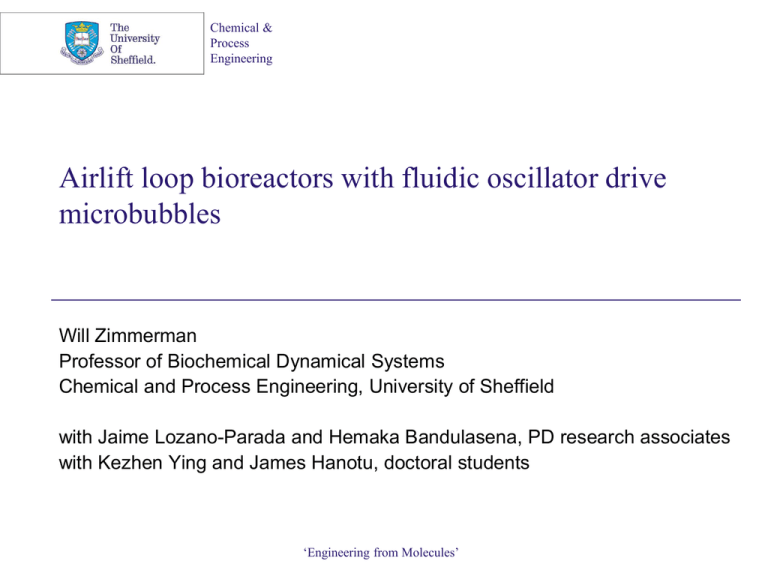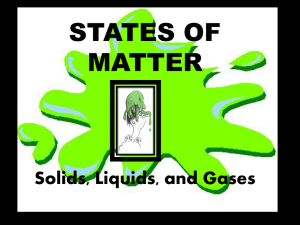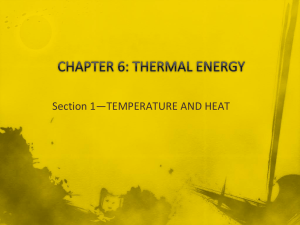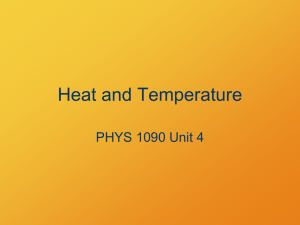airliftloop - University of Sheffield
advertisement

Chemical & Process Engineering Airlift loop bioreactors with fluidic oscillator drive microbubbles Will Zimmerman Professor of Biochemical Dynamical Systems Chemical and Process Engineering, University of Sheffield with Jaime Lozano-Parada and Hemaka Bandulasena, PD research associates with Kezhen Ying and James Hanotu, doctoral students ‘Engineering from Molecules’ Outline • Why and how microbubbles? • ALB concept • Performance studies • Steel stack gas trials • Advantages for microbial and mammalian cell ALBs • Sterilization: Ozone plasma microreactor in the lab • Prototype designs Chemical & Process Engineering ‘Engineering from Molecules’ ‘Engineering from Molecules’ Why microbubbles? Steep mass transfer enhancement. • Faster mass transfer -- roughly proportional to the inverse of the diameter • Flotation separations -- small bubbles attach to particle / droplet and the whole floc rises Chemical & Process Engineering ‘Engineering from Molecules’ ‘Engineering from Molecules’ The Fluidic oscillator What is it? No moving part, Self-excited Fluidic Amplifier. Outlets Inlet Mid Ports Linked by a feedback Loop Chemical & Process Engineering ‘Engineering from Molecules’ ‘Engineering from Molecules’ Fluidic oscillator makes microbubbles! Same Diffuser Chemical & Process Engineering • 20 micron sized bubbles from 20 micron sized pores • Rise / injection rates of 10-4 to 10-1 m/s without coalescence: uniform spacing/size ‘Engineering from Molecules’ • Watch the videos! ‘Engineering from Molecules’ Gas Inlet Relatively large coalescent and fast rising bubbles Production of Mono-dispersed Uniformly spaced, non-coalescent Microbubbles Gas Inlet Oscillatory Flow Conventional Continuous Flow Chemical & Process Engineering ‘Engineering from Molecules’ ‘Engineering from Molecules’ Air lift loop bioreactor design Schematic diagram of an internal ALB with draught tube configured with a tailor made grooved nozzle bank fed from the two outlets of the fluidic oscillator. The microbubble generator is expected to achieve nearly monodisperse, uniformly spaced, non-coalescent small bubbles of the scale of the drilled apertures. Chemical & Process Engineering • Journal article has won the 2009 IChemE Moulton Medal for best publication in all their journals. • Designed for biofuels production • First use: microalgae growth • Current TSB / Corus / Suprafilt grant on carbon sequestration feasibility study on steel stack gas feed to produce ‘Engineering from Molecules’ ‘Engineeringmicroalgae. from Molecules’ Construction Top with lid Inner view: Heat transfer coils separating riser /downcomer. Folded perforated Plate m-bubble generator. Replaced by Suprafilt 9inch diffuser Body / side view Chemical & Process Engineering ‘Engineering from Molecules’ ‘Engineering from Molecules’ Growing algae in the lab Dunaliella salina Internal of the ALB Chemical & Process Engineering The gas separator section links the riser to the downcomer at the top, permitting gas disengagement and recirculation of fluid. Consequently, this drives a ‘Engineering from Molecules’ flow from the top of the riser to the bottom. ‘Engineering from Molecules’ Gas Dissolution 7.4 7.3 7.2 7.1 7 6.9 6.8 6.7 6.6 6.5 6.4 6.3 Day 3 Fluidic Oscillator Fluidic Oscillator Day 7 Without Fluidic Oscillator pH Without F.O. 8.4 8.2 8 7.8 7.6 7.4 7.2 7 6.8 6.6 6.4 6.2 0 15 30 45 7.8 Day 10 7.6 Fluidic Oscillator Without F.O. 7.4 7.2 7 6.8 6.6 6.4 0 Chemical & Process Engineering 15 30 45 0 60 60 7.4 7.3 7.2 7.1 7 6.9 6.8 6.7 6.6 6.5 6.4 6.3 15 30 45 Time (minutes) Day 11 60 Fluidic Oscillator Without F.O. 0 ‘Engineering from Molecules’ 15 30 45 60 ‘Engineering from Molecules’ Biomass Concentration Algal biomass / bioenergy production (~30% extra biomass from CO2 microbubble dosing for only 1 hour per day). Chlorophyll Content (μg/ml) 4.00 3.50 With Fluidic Oscillator 3.00 2.50 Without Fluidic Oscillator 2.00 1.50 1.00 0.50 0.00 1 2 3 4 5 7 8 9 10 11 Time (days) Chemical & Process Engineering ‘Engineering from Molecules’ ‘Engineering from Molecules’ Current programme of field trials • Corus: steel plant algal culture • Aecom: separation/harvesting • Air lift loop bioreactor development for biofuels Approximately 1 cubic metre cube design with 0.8 m2 square ceramic microporous diffusers. Chemical & Process Engineering ‘Engineering from Molecules’ ‘Engineering from Molecules’ Features From the other experiments, Microbubbles formed from fluidic oscillation draw 18% less electricity than the same flow rate of steady flow forming larger bubbles. 1.5-2 bar gauge pressure needed. 3-4 fold better aeration rates with ~300-500 micron bubbles, up to 50 fold larger with 20 micron sized bubbles Very low shear mixing is possible at low injection rates (rise rate 10-4 m/s ) From the air-lift loop bioreactor performance, Microbubbles dissolve CO2 faster and therefore increase algal growth. Microbubbles extract the inhibitor O2 produced by the algae from the liquid so that the growth curve is wholly exponential. Algal culture with the fluidic oscillator generated bubbles had ~30% higher yield than conventionally produced bubbles with only dosing of one hour per day over a two week trial period. Bioenergy could become a more attractive option in the recycling of the high Chemical & concentration of CO2 emissions from stack gases (ongoing field trials).‘Engineering from Molecules’ Process Engineering ‘Engineering from Molecules’ Ozone Kills and mineralizes! Ozone dissolves in water to produce hydroxyl radicals One ozone molecule kills one bacterium in water! Chemical & Process Engineering Hydroxyl radical attacks bacterial cell wall, damages it by ionisation, lyses the cell (death) and finally mineralises the contents. ‘Engineering from Molecules’ ‘Engineering from Molecules’ Microfluidic onchip ozone generation Our new chip design and associated electronics produce ozone from O2 with key features: 1. Low power. Our estimates are a ten-fold reduction over conventional ozone generators. 2. High conversion. The selectivity is double that of conventional reactors (30% rather than 15% single pass). 3. Recently discovered strong irradiation in UV “killing zone” of ~300 nm. 4. Operation at atmospheric pressure, at room temperature, and at low voltage (170V, can be mains powered). Chemical & Process Engineering ‘Engineering from Molecules’ ‘Engineering from Molecules’ Plasma discs • 25 plasma reactors each with treble throughput over first microchip Chemical & Process Engineering ‘Engineering from Molecules’ ‘Engineering from Molecules’ Dosing lance assembly New lance = 70 microdisc reactors Quartz for UV irradiation Axial view of the old lance With 8 or 16 microdisc reactors Chemical & Process Engineering ‘Engineering from Molecules’ ‘Engineering from Molecules’ Consequence • Our low power ozone plasma microreactor can be inserted into the microporous diffusers to arrange for ozone dosing on demand in an ALB, for sterilization or other uses. Chemical & Process Engineering ‘Engineering from Molecules’ ‘Engineering from Molecules’







